#Katie Bouman
Explore tagged Tumblr posts
Text

#Katie Bouman#computer scientist#CHIRP algorithm#scientist#katie#engineer#real beauty is never perfect
8 notes
·
View notes
Text
I love Black Holes!
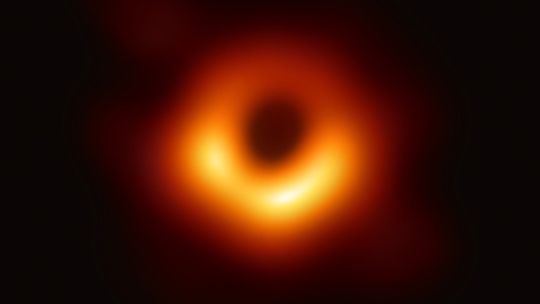
1 note
·
View note
Text

Ella es la Dra. Katie Bouman, la científica informática que obtuvo la primera imagen de un agujero negro. Desarrolló el algoritmo que convirtió los datos telescópicos en la histórica fotografía que vemos hoy.
9 notes
·
View notes
Text
Katie Bouman
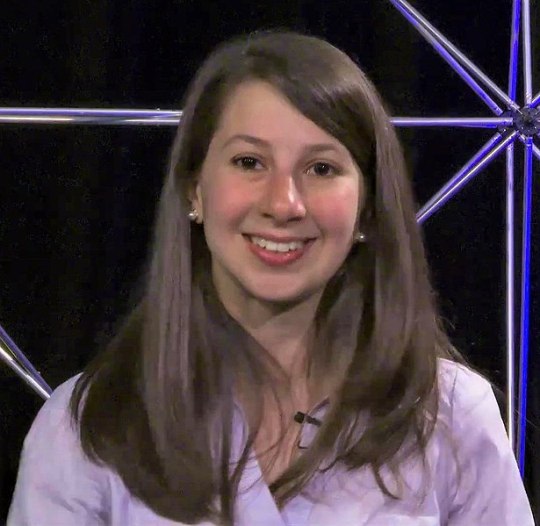
Katie Bouman was born in 1989 in West Lafayette, Indiana. Bouman worked on the Event Horizon Telescope project, which constructed the first ever photograph of a black hole. In 2019, she joined the faculty of the California Institute of Technology as an assistant professor of computing and mathematical sciences. Her research at Caltech focuses on computational imaging.
Image: National Science Foundation
56 notes
·
View notes
Text

REDWOOD CITY – The No. 4 California women's rowing team dominated the duel against No. 7 Washington sweeping all five races Saturday morning at the Redwood Shores in Redwood City. With the Bears' win in the V8+ race, the Simpson Cup, which goes to the winner of the varsity eight race, comes back to Cal for the first time since 2019. Cal's 2V8+, 3V8+, 4V8+ and V4+ also notched wins in the duel. This marks the second time this season the V8+, 3V8+ and V4+ defeated Washington as the two faced off at the San Diego Crew Classic earlier this month. "Washington brought out the best in us today," Cal head coach Al Acosta said. "We've done quite a bit of racing and travel over the last three weeks, so I was a little concerned about how much juice we'd have for this one, but the team did an amazing job of going stroke for stroke with the Huskies early and then extending the margin later in the race. Four years ago, when our seniors were freshmen, we got swept by UW, so it's very gratifying to see the seniors get this one. Now that we're halfway through the season I think we're in a good spot, but we have some big races coming up and it's not going to get any easier so we will need to continue to get faster." In the V8+ race, both boats were even through the first 20 strokes before Cal took a two-seat lead in the first 500 meters. As the boats approached the 1,000-meter mark, the Bears were ahead by a half boat. Cal kept the pressure on over the third 500 meters and extended its lead to a seat of open water. The Bears maintained that margin to take the victory in a time of 6:08.8 and bring home the Simpson Cup.
In the matchup of the 2V8+, it was fairly even off the start with Cal taking just a one-seat lead over the first 20 strokes. As the boats hit the halfway mark, the Bears kept their lead and went ahead by two seats. Cal kept the pressure on over the third 500 meters and went ahead by a half boat before extending its lead to almost a full boat over the closing 500 meters to take the win in 6:20.2. In the 3V8+ race, it was tight over the first 500 meters until Cal took a four-seat lead at the 1,000-meter mark. The Bears were able to extend their lead to open water over the third 500 meters and held that lead to finish first in a time of 6:33.2. In the 4V8+ duel, the first 500 meters were close before the Bears took a three-seat lead by the halfway mark. Cal was able to extend its lead over the third 500 meters and went ahead by a bit of open water to take the win in a time of 6:46.9. In the V4+ race, Cal got off to a good start and went ahead by two seats within the first 20 strokes. The Huskies were able to walk back a seat and pulled nearly even over the first 500 meters. By the time Cal hit the halfway mark, it was ahead by almost a boat length. The Bears continued to press and built an open-water lead over the second half of the race to get the win in a time of 6:46.9. The Bears will have next weekend off before competing in the Big Row against No. 1 Stanford on May 4 at the Redwood Shores. Results V8+ 1. Cal – 6:08.8 2. Washington – 6:12.6 2V8+ 1. Cal – 6:20.2 2. Washington – 6:23.2
3V8+ 1. Cal – 6:33.2 2. Washington – 6:40.8 4V8+ 1. Cal – 6:46.9 2. Washington – 6:50.6 V4+ 1. Cal – 6:46.9 2. Washington – 6:50.6 Lineups V8+ Coxswain - Piper Melnick Stroke: Fien van Westreenen 7: Lotta van Westreenen 6: Minou Bouman 5: Antonia Galland 4: Julia Hunt-Davis 3: Ella Wheeler 2: Star Miller Bow: Amy Furlonger
2V8+ Coxswain: Lily Wieland Stroke: Della Luke 7: Sophie Ward 6: Ella Berger 5: Tabo Stekelenburg 4: Shannon Kearney 3: Izzy Campbell 2: Sammie Henriksen Bow: Katie McDermott V4+ Coxswain: Charley Griffiths 4: Megan Culbert 3: Lola Crampin 2: Julia Irmler 1: Miya Meskis 3V8+ Coxswain: Emily Nowak Stroke: Lily Pember 7: Zoe McKernan 6: Francesca Hammerer 5: Lily Rausser 4: Nicole Weber 3: Gwyneth Fagg 2: Sophie Fussell Bow: Ella Lewerenz
4V8+ Coxswain: Julia Fullington Stroke: Claire Banks 7: Eve Barrancotto 6: Tyra Hjemdal 5: Molly Gold 4: Annie Brown 3: Sydney Koutrouba 2: Sidney Curven Bow: Kate Nixon STAY POSTED For further coverage of Cal women's rowing, follow the Bears on Instagram (@calwrowing) and Facebook (Cal Crew).
16 notes
·
View notes
Photo

Don't forget Katie Bouman, the computer scientist who was responsible for the first ever photo of a black hole.
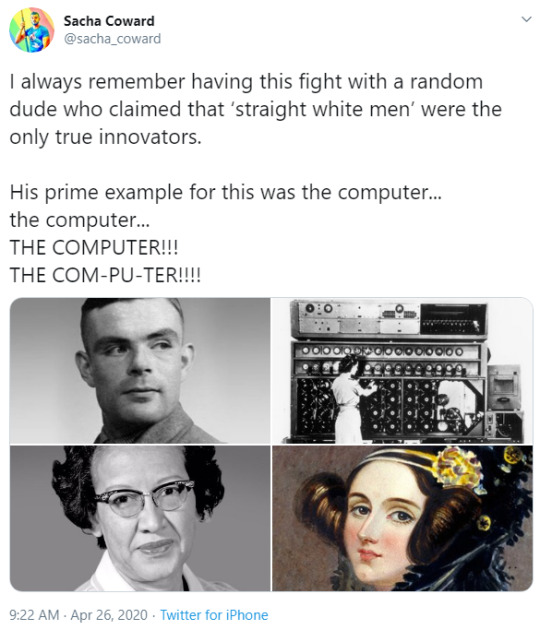
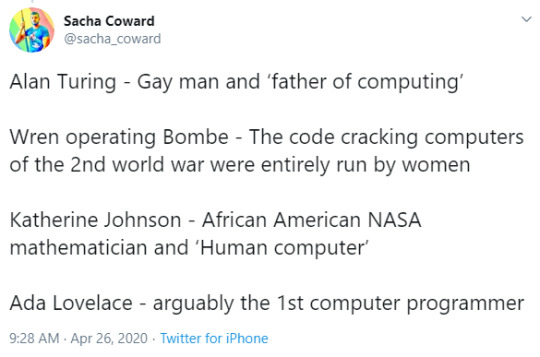

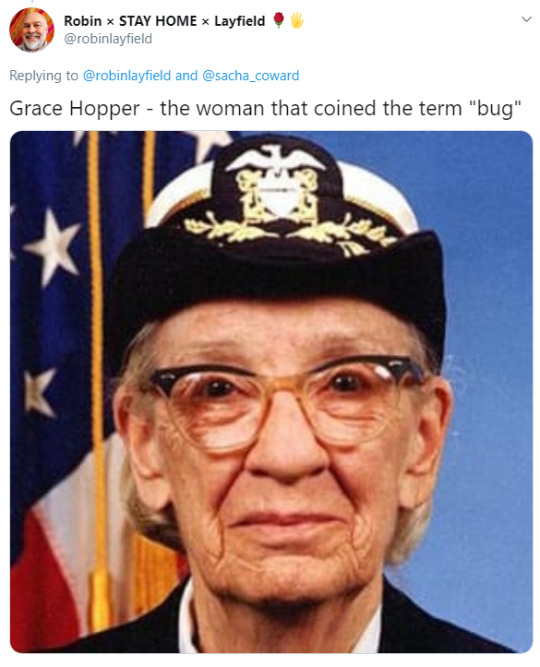
“I always remember having this fight with a random dude who claimed that ‘straight white men’ were the only true innovators. His prime example for this was the computer… the computer… THE COMPUTER!!! THE COM-PU-TER!!!
Alan Turing - Gay man and ‘father of computing’ Wren operating Bombe - The code cracking computers of the 2nd world war were entirely run by women Katherine Johnson - African American NASA mathematician and ‘Human computer’ Ada Lovelace - arguably the 1st computer programmer”
- Sacha Coward
Also Margaret Hamilton - NASA computer scientist who put the first man on the moon - an as-yet-unmatched feet of software engineering, here pictured beside the full source of that computer programme. #myhero
Grace Hopper - the woman that coined the term “bug”
- @robinlayfield
194K notes
·
View notes
Text

The first image of a black hole.
Image of M87* generated from data gathered by the Event Horizon Telescope. The algorithm that pieced together the data from the EHT was developed by Katie Bouman.
0 notes
Text
New Data, Same Great Appearance for M87* - Technology Org
New Post has been published on https://thedigitalinsider.com/new-data-same-great-appearance-for-m87-technology-org/
New Data, Same Great Appearance for M87* - Technology Org
Nearly five years ago, a globe-spanning team of astronomers gave the world its first-ever glimpse of a black hole. Now the team has validated both their original findings and our understanding of black holes with a new image of the supermassive black hole M87*.
This supermassive black hole, 6.5 billion times the mass of our Sun, resides at the center of the Messier 87 (M87) galaxy in the Virgo galaxy cluster, located 55 million light-years from Earth.
The new image, like the old one, was captured by the Event Horizon Telescope (EHT), an array of radio telescopes stretching across the planet. These new data, however, were gathered a year later, in 2018, and benefitted from enhancements in the telescope array, notably with the inclusion of a telescope in Greenland.
EHT’s original image of M87* was important not just because it represented the first time humans had imaged a black hole, but also because the object looked the way it was supposed to look. Notably, the image showed what is known as a black-hole shadow—a dark region at the center of a glowing disk of hot matter circling the black hole.
A black-hole shadow isn’t a shadow in the same sense as the one you cast when you walk outside on a sunny day. Instead, the dark region is created by the black hole’s immense gravitational field, which is so strong that light cannot escape it. Since no light leaves a black hole, it appears dark.
Additionally, that strong gravity bends light that passes near the black hole without falling into it, effectively acting like a lens. This is known as gravitational lensing, and it creates a ring of light that can be seen no matter which angle the black hole is viewed from. These effects were both predicted from Albert Einstein’s theory of general relativity. Because M87*’s image shows these effects, it is strong evidence that general relativity and our understanding of the physics of black holes is correct.
This new M87* image was produced with key contributions from an imaging team at Caltech, including Professor Katherine (Katie) L. Bouman, assistant professor of computing and mathematical sciences, electrical engineering, and astronomy; former Caltech PhD student Nitika Yadlapalli Yurk (PhD ’23); and current Caltech postdoctoral research associate in computing and mathematical sciences Aviad Levis.
Bouman is a coordinator of the EHT Imaging Working Group and was a postdoctoral fellow at the Harvard Smithsonian Center for Astrophysics and co-lead of the EHT imaging team when the original image was published in 2019. In that role, she helped develop the algorithms that assembled the trove of data collected by the EHT’s multiple radio telescopes into a single, cohesive image. Since joining the Caltech faculty, Bouman, who is also a Rosenberg Scholar and Heritage Medical Research Institute Investigator, has continued her work with EHT. She also co-led the imaging of the Milky Way’s supermassive black hole published in 2022.
Yurk joined the EHT Collaboration in 2020 and played an active role in the imaging team for the latest M87* image. Her main contributions included developing synthetic datasets to be used in the training and validation of the imaging algorithms. Yurk also wrote software that was used in the exploration of image candidates. She was recently recognized by the EHT for her efforts with a PhD Thesis Award for the advances she brought to the imaging and validation of the most recent M87* image. She is currently a NASA Postdoctoral Program fellow at JPL, which Caltech manages for NASA.
Imaging an object like M87* with the EHT is very different than imaging a planet like Saturn with a conventional telescope. Instead of seeing light, the EHT observes the radio waves emitted by objects and must computationally combine the information to form a picture.
“The raw data that comes out of these telescopes are basically just voltage values,” Yurk says. “I like to describe radio telescopes as the world’s most sensitive volt meters, and they collect voltages really accurately from different parts of the sky.”
Turning those voltage values into an image is tricky, Bouman says, because the information the researchers are working with is incomplete, and there is nothing to compare the image against since no one has seen M87* with their own eyes.
“We don’t want to plug in our expectations of what the black hole should look like when we’re computationally forming the image,” Bouman says. “Otherwise, it might lead us to an image that we expect rather than one that captures reality.”
To avoid that problem, the researchers test their image processing algorithms with what is known as synthetic data, a suite of simulated images with simple geometric shapes. Those data are run through the algorithms to produce an image. If the output image is true to the input image, they know the algorithm is working correctly and would be able to accurately see surprising structures around the black hole.
Bouman says that process, which was co-led by Yurk, involved exploring hundreds of thousands of parameters to gauge the effectiveness of the algorithms in reconstructing different image structures. The team found that with the addition of the Greenland telescope to the EHT, the methods more robustly recovered features in the images.
The process produced an image of M87* that is only slightly different than the first. The most obvious difference is that the brightest portion of the glowing ring surrounding M87* has shifted about 30 degrees counterclockwise. According to the EHT, that movement is likely the result of the turbulent flow of matter around a black hole. Importantly, the ring has remained the same size, which was also predicted by general relativity.
Bouman adds that the team’s ability to produce another image of M87* with new data that agrees so closely with the previous image is exciting.
“I think that people are going to ask, ‘Why is this important? You already showed a picture of M87*.’ Other groups have reproduced the M87* picture with data that were taken in 2017. But it’s a totally different thing to have a new dataset taken a different year and to come to the same conclusions. Reproducibility with independent data is a big deal, too.”
Written by Emily Velasco
Source: Caltech
You can offer your link to a page which is relevant to the topic of this post.
#2022#albert einstein#algorithm#Algorithms#Astronomy#Astronomy news#Astrophysics#billion#black hole#Black holes#caltech#cluster#Collaboration#computing#Dark#data#datasets#deal#earth#effects#engineering#eyes#Faculty#Features#form#Fundamental physics news#Galaxy#galaxy clusters#general relativity#Geometric
0 notes
Photo

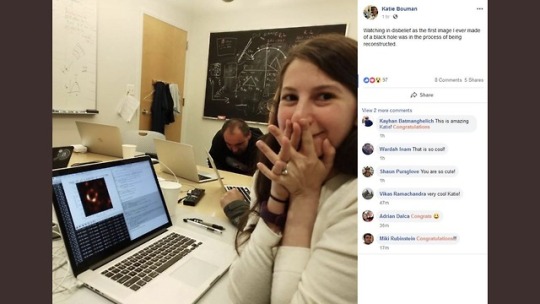
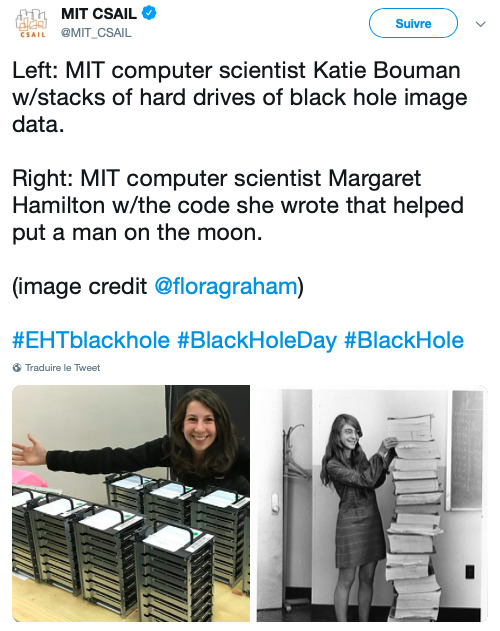
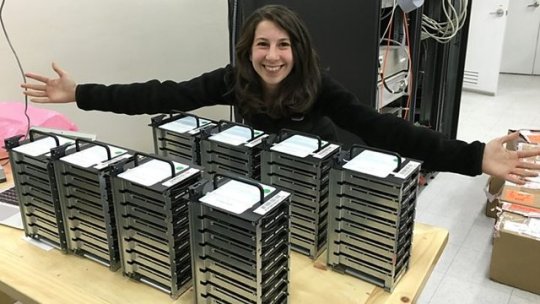
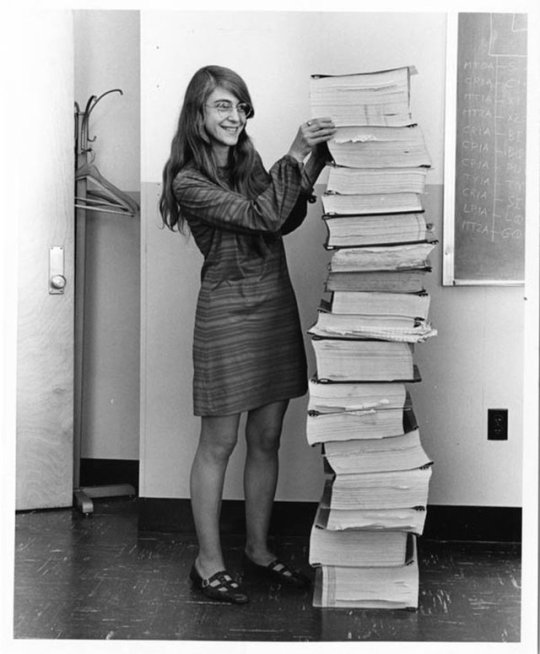
“our work should equip the next generation of women to outdo us in every field this is the legacy we’ll leave.”
- rupi kaur
171K notes
·
View notes
Text
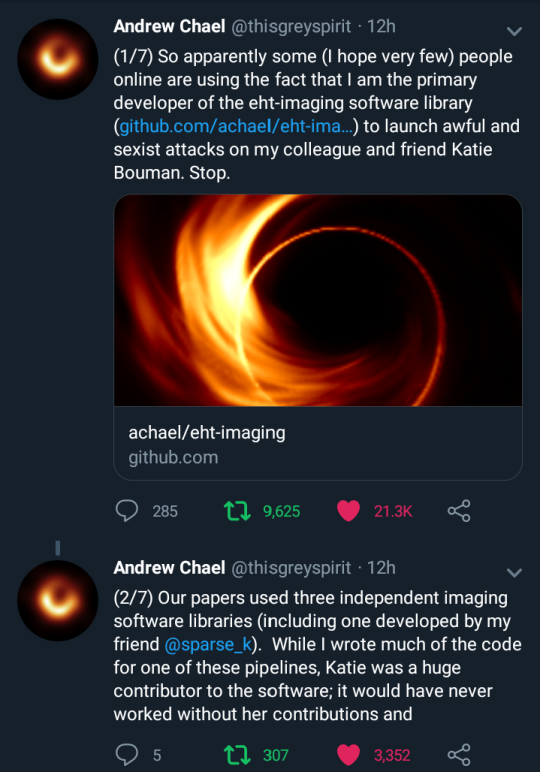
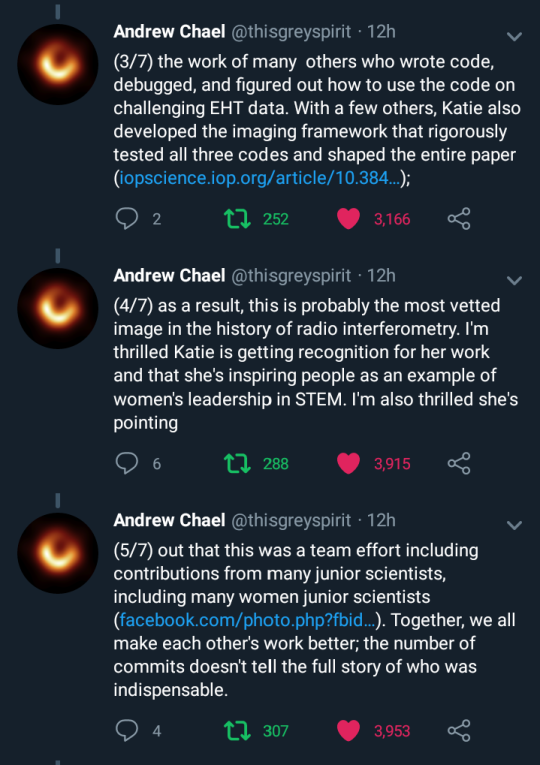
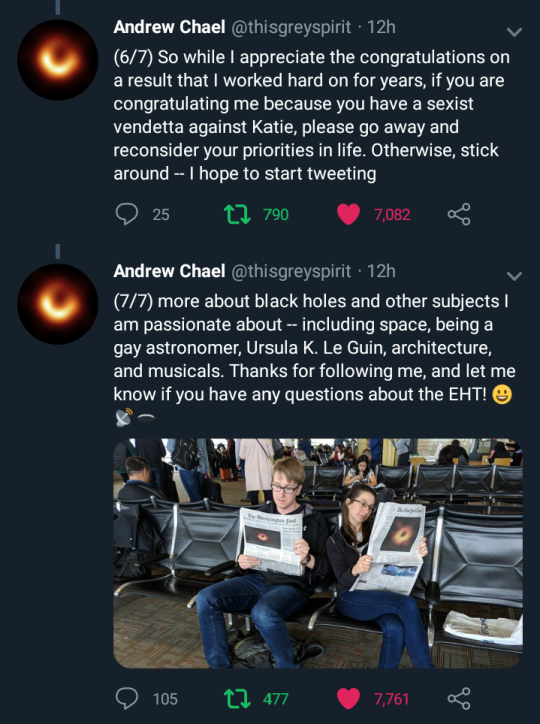
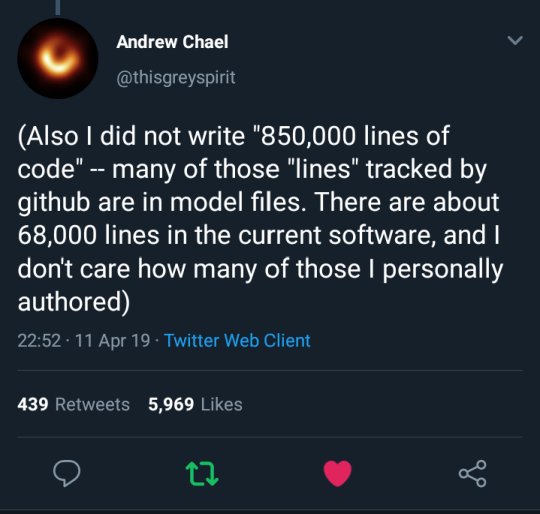
Incels and other sexist men can't see a woman doing something incredible without fuming and trying to discredit her. They're now dissing on Katie Bouman, who helped write one of the algorithms that got us the black hole picture, saying she was just an assistant (they don't know what assistant professor is), and using Andrew Chael, her colleague in the Event Horizon Telescope team who helped write one of the codes, as ~the true person behind the codes who is being erased by this anti-men society~ or whatever. They're even saying crap like "lmao women really don't do shit". Andrew took to Twitter himself to call bullshit on that.
If y'all can spread this thread to counter such narrative it'd be great.
(x)
#science#feminism#katie bouman#women in stem#event horizon telescope#andrew chael#public service announcement
69K notes
·
View notes
Text
okay guys but do you know who led the team that made it possible for us to see the picture of the black hole?

so her name is dr Katie Bouman, a 29-year-old who has created the algorhitm during grad school at MIT


the first picture shows dr Bouman when the data was being reconstructed, the second one is her with STACKS of hard drives of black hole data
(by the way, doesnt it remind you of this photo of Margaret Hamilton with her code that let us fly to the moon?)

anyway, i want for you guys to remember dr Katie Bouman because what she did is INCREDIBLE and its a huge step for us all so i REALLY hope youre gonna remember her and share this bc she DESERVES IT
(also for those of you who complain that the image is blurry; fuck off)
4K notes
·
View notes
Text


1969: Margaret Hamilton junto con el código que nos llevó a la luna.
2019: Katie Bouman junto con los datos que nos llevaron al agujero negro.
3 notes
·
View notes
Photo

3K notes
·
View notes
Text



“A black hole and its shadow have been captured in an image for the first time, a historic feat by an international network of radio telescopes called the Event Horizon Telescope (EHT).
A black hole is an extremely dense object from which no light can escape. Anything that comes within a black hole’s “event horizon,” its point of no return, will be consumed, never to re-emerge, because of the black hole’s unimaginably strong gravity. By its very nature, a black hole cannot be seen, but the hot disk of material that encircles it shines bright. Against a bright backdrop, such as this disk, a black hole appears to cast a shadow.
The stunning new image shows the shadow of the supermassive black hole in the center of Messier 87 (M87), an elliptical galaxy some 55 million light-years from Earth. This black hole is 6.5 billion times the mass of the Sun. Catching its shadow involved eight ground-based radio telescopes around the globe, operating together as if they were one telescope the size of our entire planet.”
Credit- nasa.gov
2K notes
·
View notes
Photo

This is an excellent but VERY LONG post, so I’m putting in a read more:








#katie bouman#nasa#mit#black hole#astronomy#stars#photography#computer#cs#compsci#computer science#coding#programming#women who code#girls who code#history
698 notes
·
View notes
Photo

Remember how I said there was art coming of the black hole? Props to Katie Bouman!
Redbubble
#MGHArtContest#QueerWorksFridays#QueerWorksFriday#blackhole#black hole#katie bouman#amazing women#science#scientific breakthrough#space#stars#amazing#stunning#women in history
585 notes
·
View notes